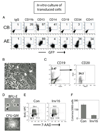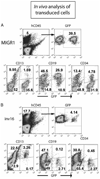Model systems for examining effects of leukemia-associated oncogenes in primary human CD34+ cells via retroviral transduction
- PMID: 19277588
- PMCID: PMC2825883
- DOI: 10.1007/978-1-59745-418-6_13
Model systems for examining effects of leukemia-associated oncogenes in primary human CD34+ cells via retroviral transduction
Abstract
The use of primary human cells to model cancer initiation and progression is now within the grasp of investigators. It has been nearly a decade since the first defined genetic elements were introduced into primary human epithelial and fibroblast cells to model oncogenesis. This approach has now been extended to the hematopoietic system, with the first described experimental transformation of primary human hematopoietic cells. Human cell model systems will lead to a better understanding of the species and cell type specific signals necessary for oncogenic initiation and progression, and will allow investigators to interrogate the cancer stem cell hypothesis using a well-defined hierarchical system that has been studied for decades. The molecular and biochemical link between self-renewal and differentiation can now be experimentally approached using primary human cells. In addition, the models that result from these experiments are likely to generate highly relevant systems for use in identification and validation of potential therapeutic targets as well as testing of small molecule therapeutics. We describe here the methodologies and reagents that are used to examine the effects of leukemia fusion protein expression on primary human hematopoietic cells, both in vitro and in vivo.
Figures



References
-
- Sharpless NE, Depinho RA. The mighty mouse: Genetically engineered mouse models in cancer drug development. Nat Rev Drug Discov. 2006;5(9):741–754. - PubMed
-
- Rangarajan A, Weinberg RA. Opinion: Comparative biology of mouse versus human cells: Modelling human cancer in mice. Nat Rev Cancer. 2003;3(12):952–959. - PubMed
-
- Rangarajan A, Hong SJ, Gifford A, Weinberg RA. Species- and cell type-specific requirements for cellular transformation. Cancer Cell. 2004;6(2):171–183. - PubMed
-
- Drayton S, Peters G. Immortalisation and transformation revisited. Curr Opin Genet Dev. 2002;12(1):98–104. - PubMed
MeSH terms
Substances
Grants and funding
LinkOut - more resources
Full Text Sources
Other Literature Sources
Medical

